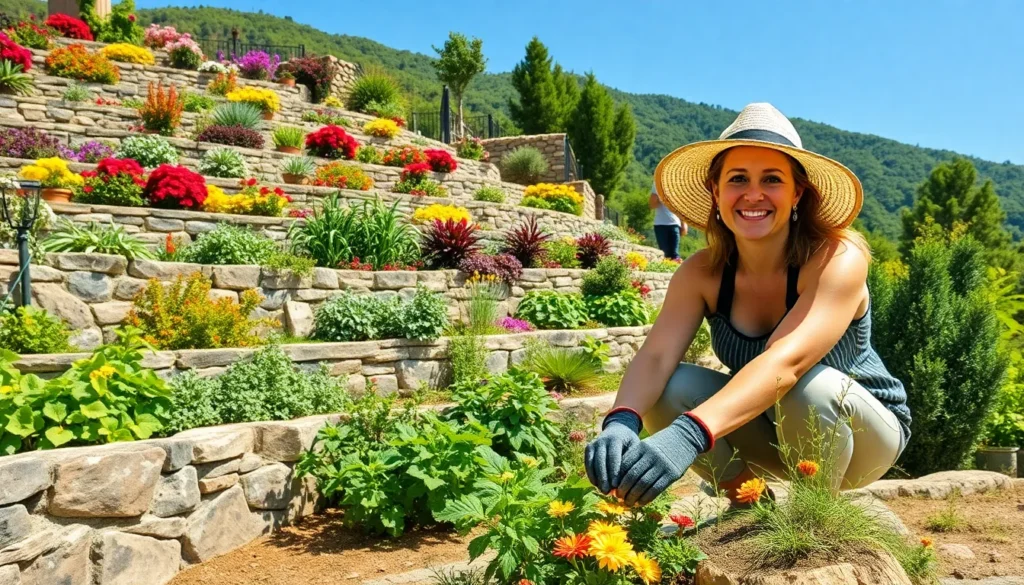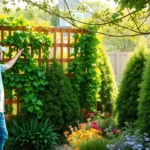Sloped landscapes present unique opportunities that flat gardens simply can’t match. We’ve discovered that gardening on a hill transforms challenging terrain into stunning visual masterpieces that capture attention from every angle.
Hillside gardens offer natural drainage advantages while creating dramatic depth and dimension in your outdoor space. We’ll show you how to work with gravity rather than against it turning steep slopes into terraced paradise gardens that prevent erosion and maximize planting space.
From retaining walls to cascading flower beds we’ve compiled proven strategies that make hillside gardening both practical and breathtaking. Whether you’re dealing with a gentle slope or a dramatic incline these garden on a hill ideas will help you create an outdoor sanctuary that’s as functional as it is beautiful.
Terraced Garden Beds for Maximum Growing Space
Terraced garden beds transform challenging hillside slopes into productive growing spaces while adding stunning visual appeal to our industry. We’ll maximize every square foot of available planting area through strategic design and proper construction techniques.
Creating Level Planting Areas
Building terraced beds starts with measuring the slope gradient and determining the ideal width for each level. We recommend creating terraces between 3 to 6 feet wide to ensure easy access for maintenance and harvesting. Wider terraces work best on gentle slopes while narrower ones suit steeper inclines.
Excavating begins at the bottom of the slope and works upward to prevent soil displacement. We dig into the hillside to create a flat foundation for each terrace wall. The excavated soil becomes fill material for building up the lower section of each level. Proper grading ensures water flows across each terrace rather than rushing downhill.
Installing drainage systems prevents water buildup that can damage retaining structures. We place perforated drain pipes behind each retaining wall and cover them with gravel before backfilling with soil. French drains or weep holes every 6 to 8 feet allow excess moisture to escape safely.
Choosing Appropriate Retaining Wall Materials
Stone retaining walls offer natural beauty and exceptional durability for terraced gardens. Fieldstone and flagstone work particularly well because they blend seamlessly with outdoor environments. We select stones that are at least 6 inches thick for walls under 3 feet high and thicker stones for taller structures.
Concrete blocks provide affordable options with consistent sizing that simplifies construction. Interlocking blocks create stable walls without requiring mortar or special tools. We choose textured or colored blocks that complement our garden’s aesthetic rather than plain gray varieties.
Timber retaining walls suit informal garden styles and cost less than stone alternatives. Pressure treated lumber or naturally resistant woods like cedar resist decay and insect damage. We anchor timber walls with metal brackets or concrete footings to prevent shifting over time.
Gabion walls filled with rocks create modern terraced gardens with excellent drainage properties. These wire mesh containers allow water to flow through while holding soil in place. We fill gabions with local stone or recycled concrete for sustainable construction options.
Selecting Plants for Each Terrace Level
Upper terraces receive the most sunlight and drain fastest, making them perfect for Mediterranean herbs and drought tolerant perennials. Lavender, rosemary, and ornamental grasses thrive in these drier conditions. We plant vegetables like tomatoes and peppers that need excellent drainage and full sun exposure.
Middle terraces offer moderate moisture levels ideal for most garden vegetables and flowering plants. Root vegetables such as carrots and beets grow well in these stable conditions. Annual flowers like marigolds and zinnias provide continuous color throughout the growing season.
Lower terraces collect more moisture and may receive partial shade from upper plantings. Leafy greens including lettuce and spinach flourish in these cooler, damper conditions. We establish hostas and ferns for shaded areas that receive minimal direct sunlight.
Ground covers prevent soil erosion between terraced levels while adding visual continuity. Creeping thyme and sedum spread naturally to fill gaps in retaining walls. We plant trailing varieties like ivy or vinca to cascade down terrace faces for softened edges.
Slope Stabilization Techniques to Prevent Erosion
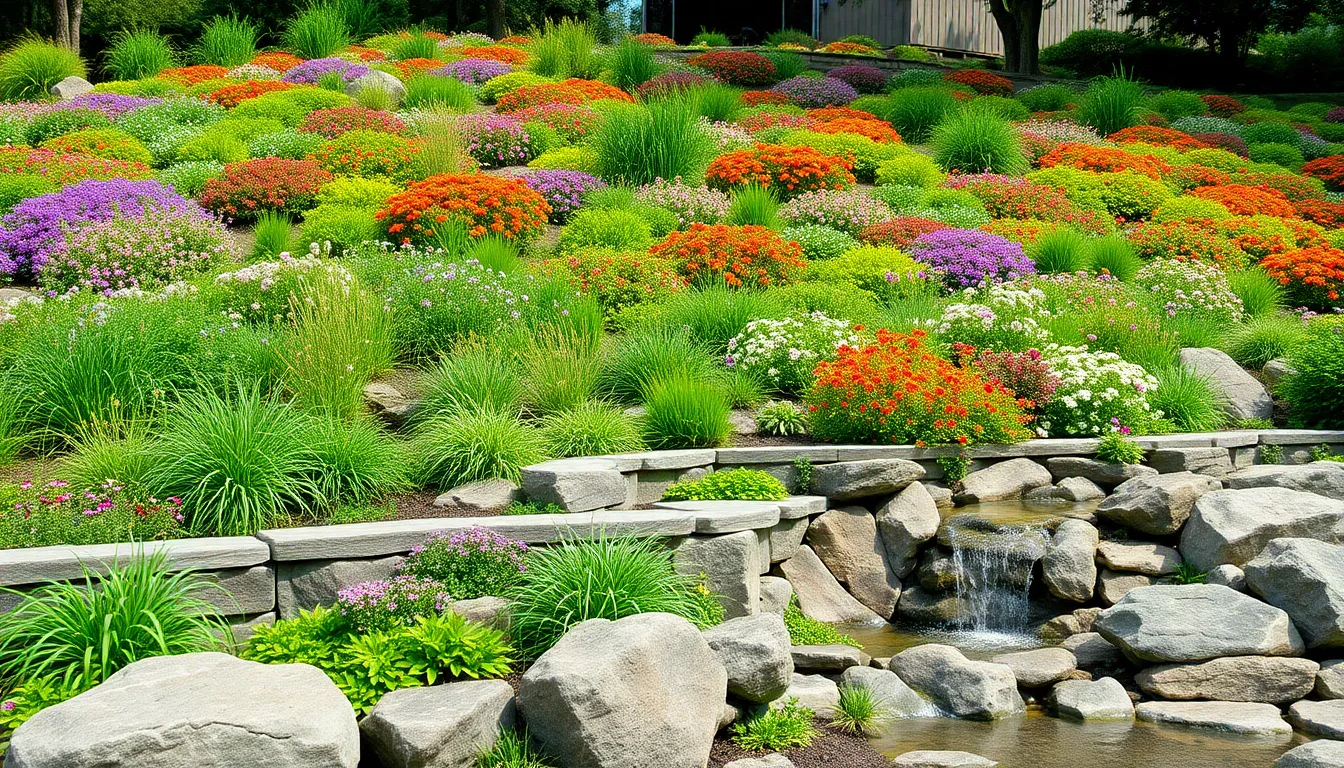
Effective slope stabilization goes beyond terracing and retaining walls to include comprehensive erosion control strategies. We’ll explore three fundamental approaches that work together to secure your hillside garden naturally.
Installing Ground Cover Plants
Anchoring plants serve as nature’s most effective erosion control system by establishing robust root networks that grip the soil. We recommend planting shrubs and ornamental grasses strategically across your slope to create multiple stabilization points. Prairie plants like coneflower excel at this task because their deep root systems penetrate several feet into the hillside.
Ground covers spread horizontally to form living carpets that protect exposed soil from rain impact and wind erosion. We suggest selecting low-growing varieties such as creeping phlox, ajuga, or pachysandra for areas between larger anchor plants. These species quickly establish dense coverage while requiring minimal maintenance once established.
Alpine gardens offer specialized answers for rocky hillsides where traditional ground covers struggle to thrive. We’ve found that plants like corydalis adapt perfectly to rocky conditions and create stunning displays while preventing soil movement. Rock garden plants naturally develop strong root systems that work between stones to stabilize loose material.
Building Strategic Drainage Systems
Proper drainage prevents water from accumulating behind retaining walls and causing structural failure or soil saturation. We incorporate gaps in our retaining wall designs to allow water flow through rather than building pressure against the structure. These weep holes should be spaced every 6 to 8 feet along the wall’s length.
Water features can enhance drainage naturally while adding aesthetic appeal to your hillside garden. We design waterfalls and streams that channel runoff down predetermined paths rather than allowing water to carve its own erosive channels. Stone-lined channels guide water flow and prevent undercutting of planted areas.
French drains work effectively behind terraced areas to collect subsurface water before it can destabilize the slope. We install perforated pipes wrapped in industry fabric and surrounded by gravel to create invisible drainage systems. These systems redirect water to safe outlet points away from vulnerable garden areas.
Using Mulch and Natural Barriers
Pea gravel serves dual purposes as both mulch and erosion prevention while unifying your garden’s appearance across different elevation levels. We apply 2 to 3 inches of pea gravel around plants to prevent runoff while allowing water infiltration. This material stays in place better than organic mulches on steep slopes.
Natural barriers using hypertufa and stone create attractive edges that contain soil and mulch materials. We position these barriers strategically to slow water movement and trap sediment before it can wash away. Hypertufa planters can be integrated into slopes to create both barriers and planting opportunities.
Rock placement reinforces hillsides while providing visual interest and habitat diversity in your garden design. We select large stones that won’t shift during heavy rains and position them to break up long slope runs. These natural anchors create microclimates and planting pockets while serving as permanent erosion control features.
Rock Garden Designs for Challenging Terrain
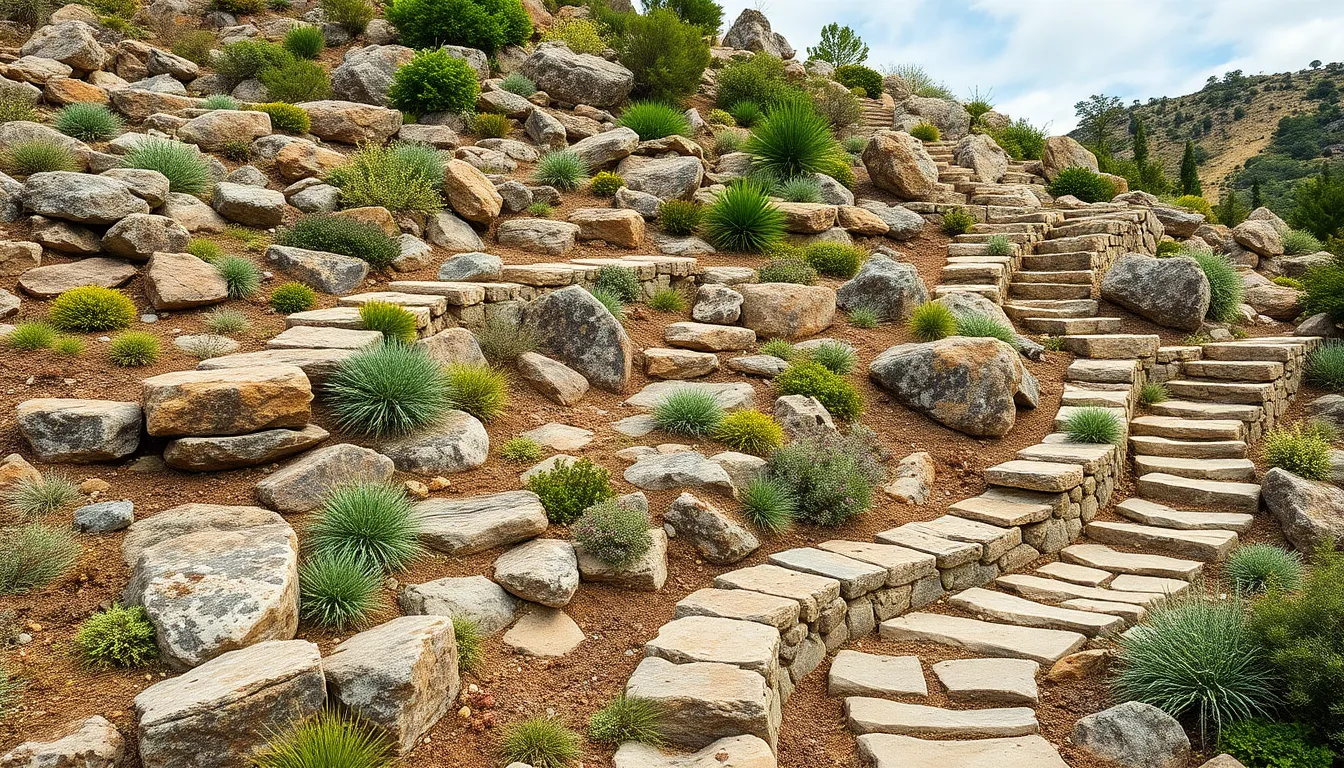
Challenging hillside terrain presents unique opportunities to create stunning rock gardens that work with nature’s existing features. We’ll explore how to transform difficult slopes into beautiful, low-maintenance landscapes using strategic design principles.
Incorporating Native Stone Features
Utilizing existing rocks creates the foundation for our hillside rock garden design. We recommend using natural stone materials like hypertufa or artificial limestone that blend seamlessly with your industry’s existing features[3]. These materials help create unique focal points such as natural steps and elevated platforms.
Choosing rough boulders adds visual weight and authenticity to challenging terrain. We suggest selecting native materials that harmonize with your hillside’s natural industry characteristics[5]. Large stones serve as anchor points that define different garden zones while providing structural support.
Integrating stone features requires careful consideration of your home’s exterior style. We focus on creating cohesive designs that complement existing architectural elements[5]. Natural stone placement should follow the hillside’s contours to maintain an organic appearance.
Selecting Alpine and Drought-Resistant Plants
Choosing deep-rooted plants provides essential slope stabilization for challenging terrain. We recommend shrubs, ornamental grasses, and prairie plants that develop extensive root systems to secure hillside soil[3]. These plants create natural erosion barriers while requiring minimal maintenance.
Selecting drought-tolerant species reduces long-term care requirements and supports local ecosystems. We prioritize plants that thrive in rocky, well-draining conditions typical of hillside environments[5]. Alpine varieties naturally adapt to harsh growing conditions found on steep slopes.
Installing large evergreens creates visual anchors that provide year-round structure. We suggest allowing self-sowing perennials to fill gaps between larger plantings, which softens rocky ledges naturally[3]. This approach creates a balanced network that maintains itself over time.
Creating Natural-Looking Pathways
Building terraced walkways provides safe access while preventing soil erosion. We recommend using stepping stones that follow the hillside’s natural grade to create visually appealing pathways[3][4]. Terracing creates distinct levels that make steep slopes more manageable.
Incorporating gravel pathways enhances drainage while maintaining the garden’s natural aesthetic. We suggest using stone materials that complement existing rock features throughout the industry[2][4]. These materials prevent erosion while providing stable walking surfaces.
Creating stepping stone sequences allows us to navigate challenging terrain safely. We design pathways that wind naturally through rock outcroppings and planted areas. Strategic placement ensures each step provides secure footing while maintaining the garden’s organic flow.
Vertical Gardening Solutions for Steep Inclines
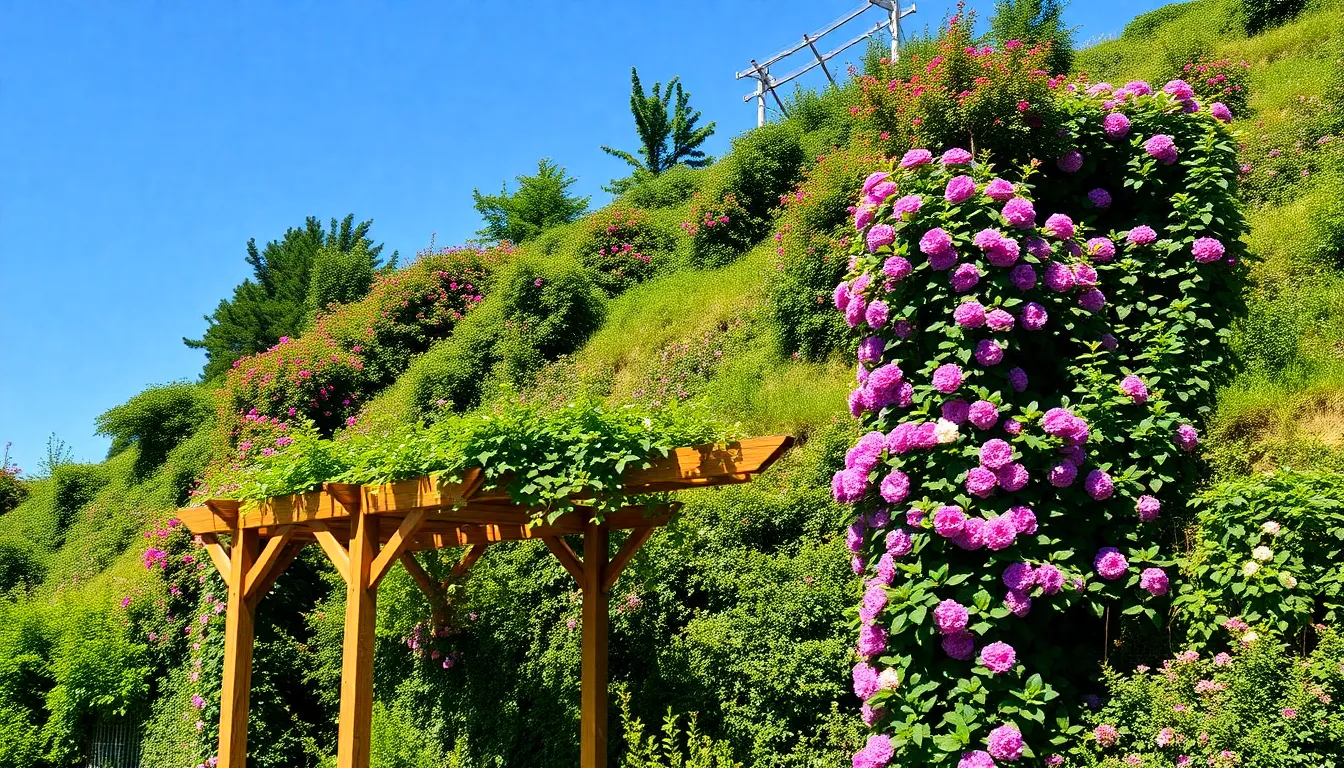
Steep slopes present unique opportunities for creating dramatic vertical displays that maximize planting space while working with challenging terrain. We’ll explore proven methods to transform difficult inclines into thriving garden features.
Installing Trellis Systems and Support Structures
Trellis placement against walls or fences maximizes vertical space on steep slopes. We recommend positioning these structures at the base of inclines to support climbing plants that’ll naturally grow upward along the slope’s contour. Secure mounting becomes critical on uneven terrain, requiring heavy-duty brackets anchored into stable ground or retaining wall surfaces.
Support structures like arches and arbors add both function and beauty to hillside gardens. These frameworks create defined pathways while providing climbing surfaces for vines and flowering plants. We suggest installing them at strategic points where natural terracing occurs, allowing easy access for maintenance while creating stunning focal points.
Stakes and cages work perfectly for plants that need support but don’t climb naturally. Heavy-duty metal stakes driven deep into slope soil provide stability for tall perennials and vegetables. We’ve found that triangular cage systems distribute weight better than single stakes, preventing toppling during heavy rains or strong winds.
Choosing Climbing Plants and Vines
Clematis and roses thrive on trellises while adding vibrant color to steep garden areas. These climbing varieties establish strong root systems that help stabilize soil while creating spectacular vertical displays. We recommend selecting repeat-blooming varieties like ‘New Dawn’ roses or ‘Jackmanii’ clematis for continuous seasonal interest.
Ivy and honeysuckle cover walls and slopes effectively while reducing soil erosion. These vigorous vines create dense coverage that protects exposed soil from rainfall impact. We suggest choosing native varieties like Virginia creeper or trumpet honeysuckle, which provide wildlife habitat while requiring minimal maintenance once established.
Fast-growing annual vines offer quick answers for new hillside installations. Morning glories, sweet peas, and nasturtiums establish rapidly from seed, providing immediate erosion control while permanent plantings mature. We plant these annuals in spring to create temporary coverage during the first growing season.
Creating Living Wall Features
Green walls using planters or modular systems transform steep inclines into lush vertical gardens. These installations work particularly well on constructed retaining walls, where we can attach modular planting pockets directly to stable surfaces. Proper drainage becomes essential, with each planting pocket requiring individual water management to prevent root rot.
Vertical planters stacked in tiers create impressive plant walls with minimal ground footprint. We arrange these systems in staggered patterns that follow the natural slope contour, creating depth and visual interest. Self-watering varieties reduce maintenance requirements while ensuring consistent moisture delivery to plants at different elevations.
Pocket planting systems integrated into retaining walls maximize growing space on steep terrain. These built-in planters become permanent features that don’t require additional structural support. We design these pockets with proper drainage outlets and soil depth requirements for exact plant types, ensuring long-term success without compromising wall integrity.
Water Management Strategies for Hillside Gardens
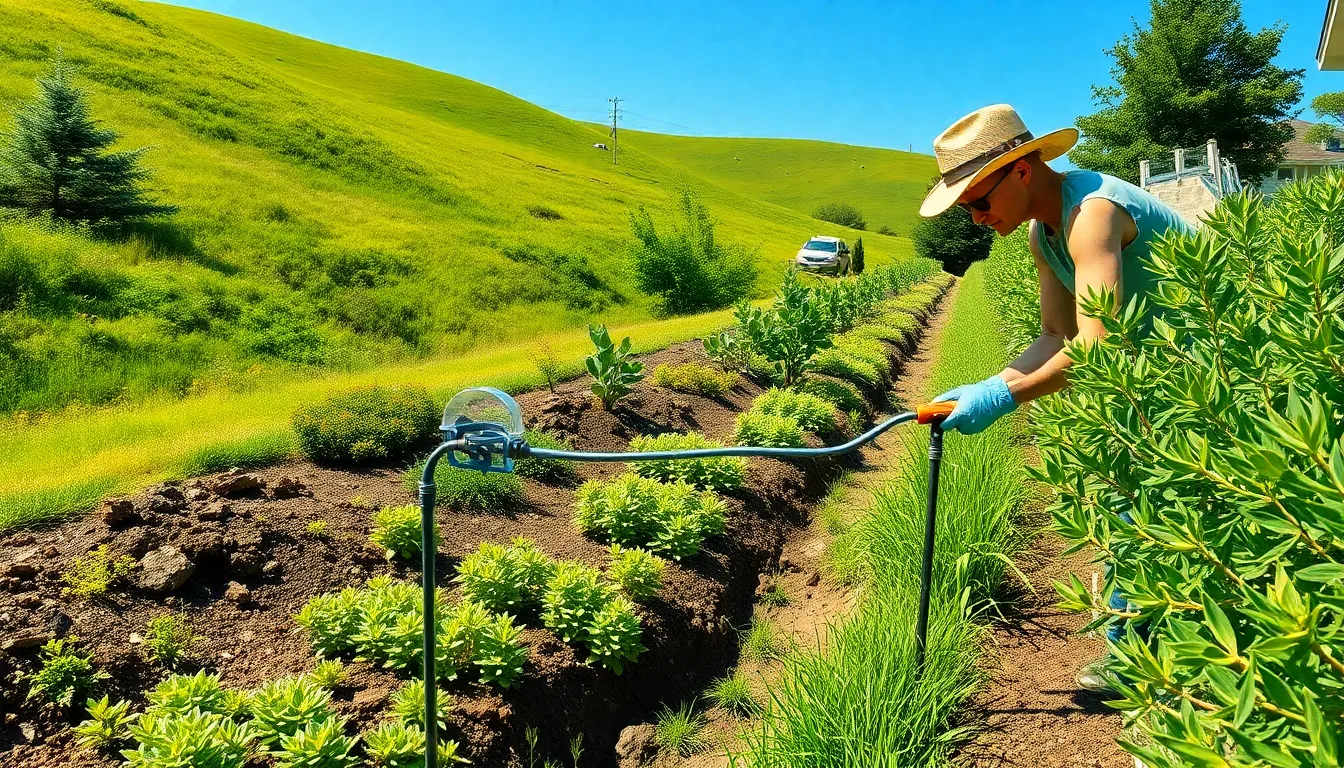
Proper water management transforms challenging hillside terrain into thriving garden spaces while preventing costly erosion damage. We’ll explore three essential approaches that redirect water flow and maintain healthy soil conditions on slopes.
Installing French Drains and Diversion Channels
French drains provide the most effective underground solution for redirecting excess water away from your hillside garden. These trench-like structures combine gravel or porous materials with perforated pipes to channel water away from vulnerable planting areas. We recommend installing them at key collection points where water naturally accumulates during heavy rainfall.
Diversion channels work above ground to redirect water flow before it reaches sensitive slope areas. These strategic channels prevent erosion by guiding runoff toward designated drainage areas rather than allowing it to cascade down your garden beds. Position them at the top of slopes and along natural water paths to maximize their effectiveness.
Creating Rain Gardens and Bioswales
Rain gardens capture and filter stormwater in shallow depressions designed specifically for your hillside’s natural water flow patterns. These planted areas collect rainwater runoff and allow it to slowly infiltrate the soil rather than rushing down the slope. We suggest incorporating native vegetation that tolerates both wet and dry conditions to ensure year-round functionality.
Bioswales serve as living filtration systems that capture and purify stormwater before it leaves your property. These engineered industry features combine the water management benefits of rain gardens with enhanced filtration capabilities through specially selected plants. Design them to follow the natural contours of your hillside for optimal water collection and treatment.
Positioning Irrigation Systems Effectively
Drip irrigation systems deliver water directly to plant roots with minimal runoff, making them ideal for hillside gardens where water conservation is critical. These systems provide consistent moisture levels while reducing water waste that typically occurs with traditional sprinkler methods on slopes.
Soaker hoses offer another low-volume irrigation option that releases water slowly along their entire length. Position them strategically throughout your hillside plantings to ensure even water distribution without creating erosion-causing runoff.
Mist sprinklers work best for newly seeded slope areas where gentle water application prevents seed displacement. Stop irrigation immediately when water begins running down the slope to avoid washing away your newly planted areas.
| Irrigation Method | Water Delivery Rate | Best Use Case |
|---|---|---|
| Drip irrigation | 1-4 gallons per hour | Established plants and shrubs |
| Soaker hoses | 2-6 gallons per hour | Row plantings and ground cover |
| Mist sprinklers | Variable flow | Seed establishment areas |
Pathway and Access Planning for Hill Gardens
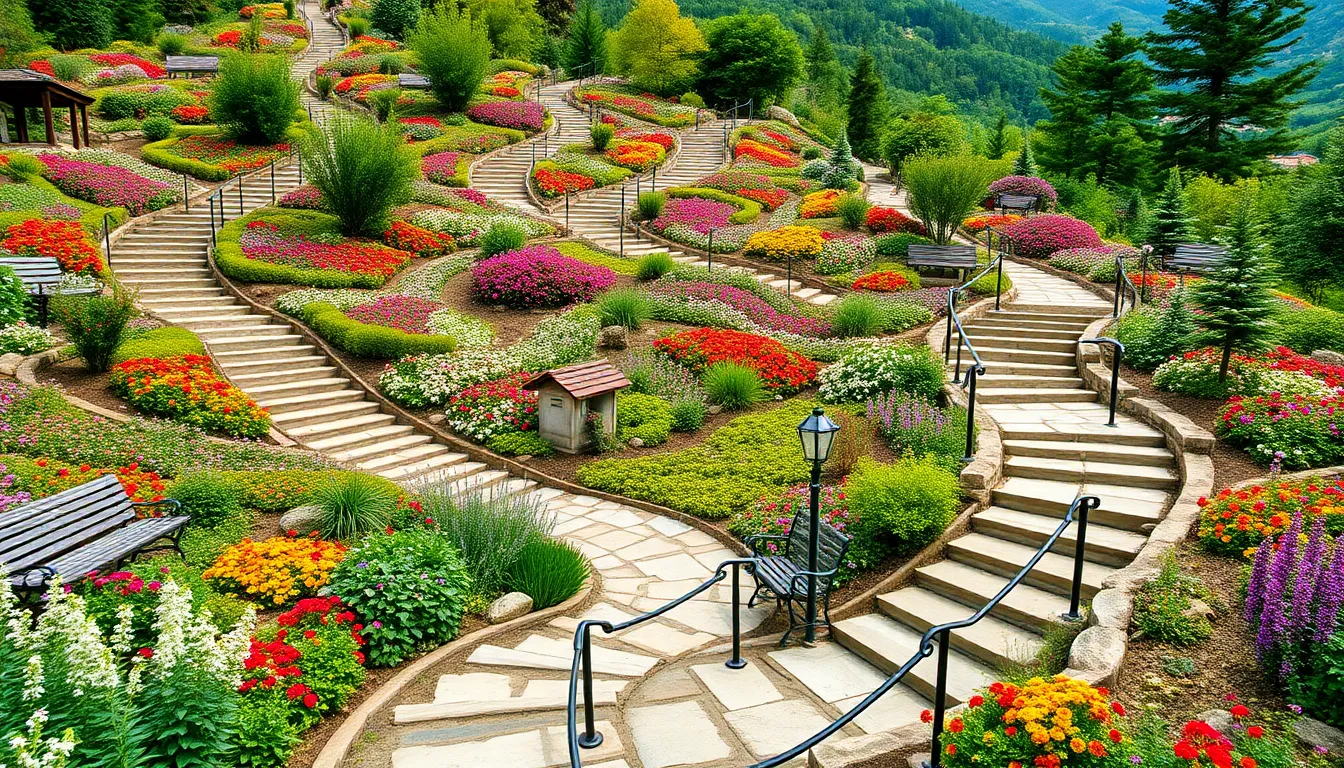
Creating safe and accessible routes through your hillside garden ensures everyone can enjoy the beauty you’ve cultivated while maintaining the natural flow of the industry.
Designing Switchback Trails
Switchback trails offer the most effective solution for handling steep terrain while reducing physical strain on visitors. These zigzag pathways cut the slope angle in half, making ascents manageable for people of all fitness levels. We recommend designing each switchback segment to maintain a grade no steeper than 8-10% for comfortable walking.
Planning your trail width ensures safe passage and allows two people to walk side by side comfortably. Standard switchback paths should measure 4-6 feet wide, providing adequate space for movement while accommodating garden maintenance equipment. Natural materials like decomposed granite or mulched bark create attractive surfaces that blend seamlessly with your hillside environment.
Strategic placement of switchback turns maximizes both functionality and visual appeal throughout your garden. Position each turn at natural resting points where visitors can pause and appreciate different garden vistas. This approach transforms the journey into an experience rather than simply a means to reach the top.
Installing Steps and Handrails for Safety
Stone steps provide the most durable and visually appealing solution for steep garden sections that require direct vertical access. Natural fieldstone or cut stone blocks create sturdy treads that weather beautifully over time. Each step should measure 12-15 inches deep and 6-8 inches high for comfortable navigation.
Wooden steps offer a cost effective alternative that complements rustic garden designs while providing reliable access. Pressure treated lumber or naturally rot resistant woods like cedar ensure longevity in outdoor conditions. We recommend using 2×12 inch planks for treads and securing them with galvanized hardware.
Handrails become essential safety features when your steps exceed three risers or navigate particularly steep terrain. Install rails at 36 inches high using materials that match your step construction, whether stone pillars with metal rails or wooden posts with rope or cable infill. Proper anchoring into solid ground or retaining walls ensures stability under load.
Creating Rest Areas and Viewing Points
Strategically placed seating areas transform challenging climbs into enjoyable garden experiences that encourage longer visits. Position benches or built in stone seating every 50-75 feet along steep pathways, allowing visitors to rest while taking in panoramic views. These rest stops should feature level ground and stable footing for safety.
Viewing platforms maximize the dramatic vistas available from elevated garden positions while providing destinations that justify the climb. Construct small decks or stone terraces at key viewpoints, ensuring they’re large enough for multiple visitors and positioned to capture the best angles of your garden and surrounding industry.
Integration of focal points at rest areas enhances the overall garden experience and creates memorable stopping points. Consider installing water features, sculptural elements, or specimen plants at these locations to reward visitors for their journey upward. These features also serve as navigation landmarks, helping visitors orient themselves within your hillside garden layout.
Plant Selection for Sloped Garden Conditions
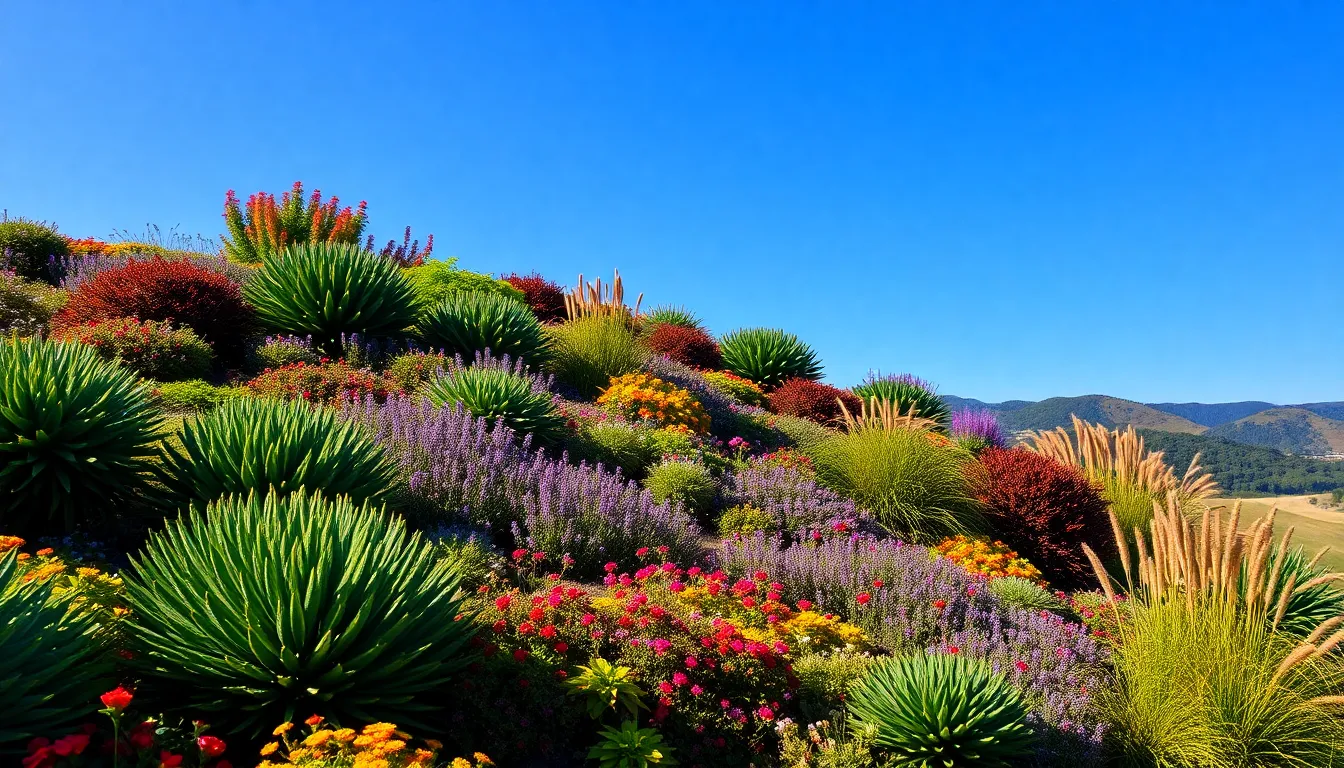
Successful hillside gardens depend on choosing plants that thrive in sloped conditions while providing essential erosion control. We’ll explore how different plant types work together to create stable, beautiful hillside landscapes.
Choosing Deep-Rooted Erosion Control Plants
Deep-rooted plants form the foundation of any successful sloped garden by creating underground networks that grip and stabilize soil. Shrubs like serviceberry and elderberry develop extensive root systems that penetrate several feet deep, anchoring loose soil on steep inclines. Ornamental grasses such as fountain grass and feather reed grass create dense fibrous root mats that spread horizontally while reaching deep into the earth.
Prairie plants offer exceptional erosion control benefits through their naturally evolved root structures. Coneflower develops roots that extend 3-5 feet deep while spreading laterally to form interconnected soil-gripping networks. Black-eyed Susan and wild bergamot similarly create extensive underground systems that prevent soil movement during heavy rains.
Native plants provide superior erosion control because they’re genetically adapted to local soil conditions and weather patterns. Species like native sumac and dogwood establish quickly and require minimal maintenance once their root systems mature. These plants also support local wildlife populations while creating natural habitat corridors along your hillside.
Trees and shrubs serve as permanent anchors for steep slopes, with evergreen varieties offering year-round soil protection. Pine trees and juniper bushes provide weight and stability while their needle drop creates natural mulch that further prevents erosion.
Selecting Shade-Tolerant Species for Lower Areas
Lower hillside areas typically receive filtered sunlight due to upper slope plantings and natural terrain features. Creeping groundcovers like pachysandra and wild ginger spread rapidly in shaded conditions, forming dense carpets that prevent soil erosion while requiring minimal care.
Hostas thrive in partial shade environments and offer dramatic foliage that creates visual interest in lower garden areas. Varieties like ‘Sum and Substance’ and ‘Blue Angel’ develop substantial root systems that help stabilize soil while providing stunning architectural elements.
Ferns naturally colonize shaded hillside areas and create lush, woodland-style gardens that require virtually no maintenance. Christmas fern and royal fern establish quickly in moist, shaded conditions while their spreading rhizomes create effective erosion barriers.
Perennials like astilbe and coral bells add seasonal color to shaded lower slopes while developing strong root networks. These plants tolerate the increased moisture that naturally accumulates in lower hillside areas.
Incorporating Sun-Loving Plants for Upper Slopes
Upper slopes receive direct sunlight for most of the day, creating ideal conditions for drought-tolerant and sun-loving species. Succulents like sedum and hens-and-chicks store water in their leaves, making them perfect for areas that experience rapid drainage and intense sun exposure.
Drought-tolerant perennials such as lavender and Russian sage thrive in full sun conditions while requiring minimal water once established. These plants develop deep taproots that access moisture from lower soil levels while their above-ground growth creates attractive focal points.
Mediterranean herbs like rosemary and thyme flourish on sunny upper slopes, providing both culinary value and erosion control. Their aromatic foliage releases pleasant scents when brushed against, creating sensory experiences along garden pathways.
Ornamental grasses like blue fescue and buffalo grass create striking textural contrasts on sun-drenched upper slopes. These grasses tolerate extreme heat and drought while their root systems effectively prevent soil erosion during storm events.
Design Ideas for Different Hill Garden Styles
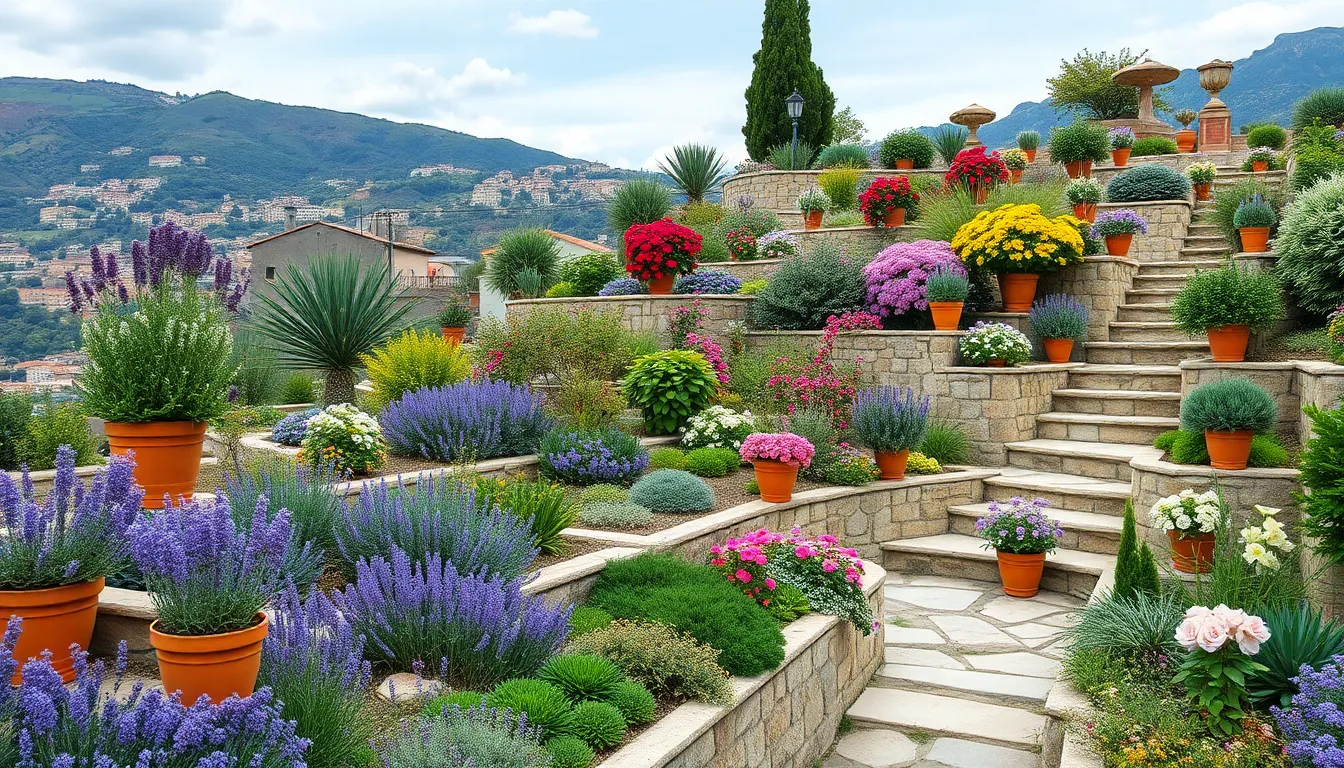
We’ll explore three distinct design approaches that transform sloped landscapes into stunning outdoor retreats. Each style offers unique aesthetic and functional benefits that complement your hillside’s natural characteristics.
Mediterranean-Inspired Hillside Gardens
Mediterranean hillside gardens embrace drought-resistant plants that thrive in well-draining sloped conditions. We recommend incorporating lavender, rosemary, and olive trees as foundational plants that establish authentic Mediterranean character while providing natural slope stabilization.
Stone walls create essential structure and visual appeal in Mediterranean garden designs. Terracotta pots positioned strategically throughout the garden add warm, rustic elements that complement the natural hillside setting. Gravel pathways wind through the garden space, creating meandering routes that highlight the slope’s natural beauty.
Warm color palettes dominate Mediterranean hillside designs, featuring plants with silver-green foliage and purple, blue, and yellow blooms. We suggest planting herbs like thyme and oregano between larger anchor plants to fill spaces while providing culinary benefits. These aromatic plants release fragrance when brushed against, improving the sensory garden experience.
English Cottage Garden Adaptations
English cottage gardens adapt beautifully to hillside settings through tiered planting arrangements and abundant flowering displays. We create stacked stone walls that stabilize slopes while supporting the cottage garden’s characteristic overflow of blooming perennials and shrubs.
Roses serve as cornerstone plants in cottage-style hillside gardens, providing vertical interest and seasonal color. Lavender planted alongside pathways creates fragrant borders that complement the cottage aesthetic. Mixed perennial borders cascade down the slope, creating layers of texture and seasonal interest.
Natural stone walls and wooden fences define garden rooms within the hillside cottage design. Meandering paths connect different garden levels, encouraging exploration while providing practical access for maintenance. We incorporate traditional cottage plants like delphiniums, foxgloves, and hollyhocks that adapt well to sloped conditions.
Modern Minimalist Slope Designs
Modern minimalist hillside gardens emphasize clean lines and structural elements that work with the slope’s natural geometry. We use materials like wood, metal, and concrete to create sleek retaining walls and contemporary pathways that define the garden’s architectural framework.
Large boulders serve as sculptural focal points while providing natural erosion control on steep slopes. Evergreen plants maintain year-round structure and visual consistency in minimalist designs. We select plants with strong architectural forms like ornamental grasses and succulents that require minimal maintenance.
Concrete and steel retaining walls create dramatic modern elements that contrast beautifully with natural plantings. Linear pathways follow the slope’s contours, emphasizing the hillside’s natural lines rather than fighting against them. Gravel surfaces and mulched planting beds maintain the clean, uncluttered aesthetic while providing practical growing conditions for selected plants.
Maintenance Tips for Sustainable Hill Gardening
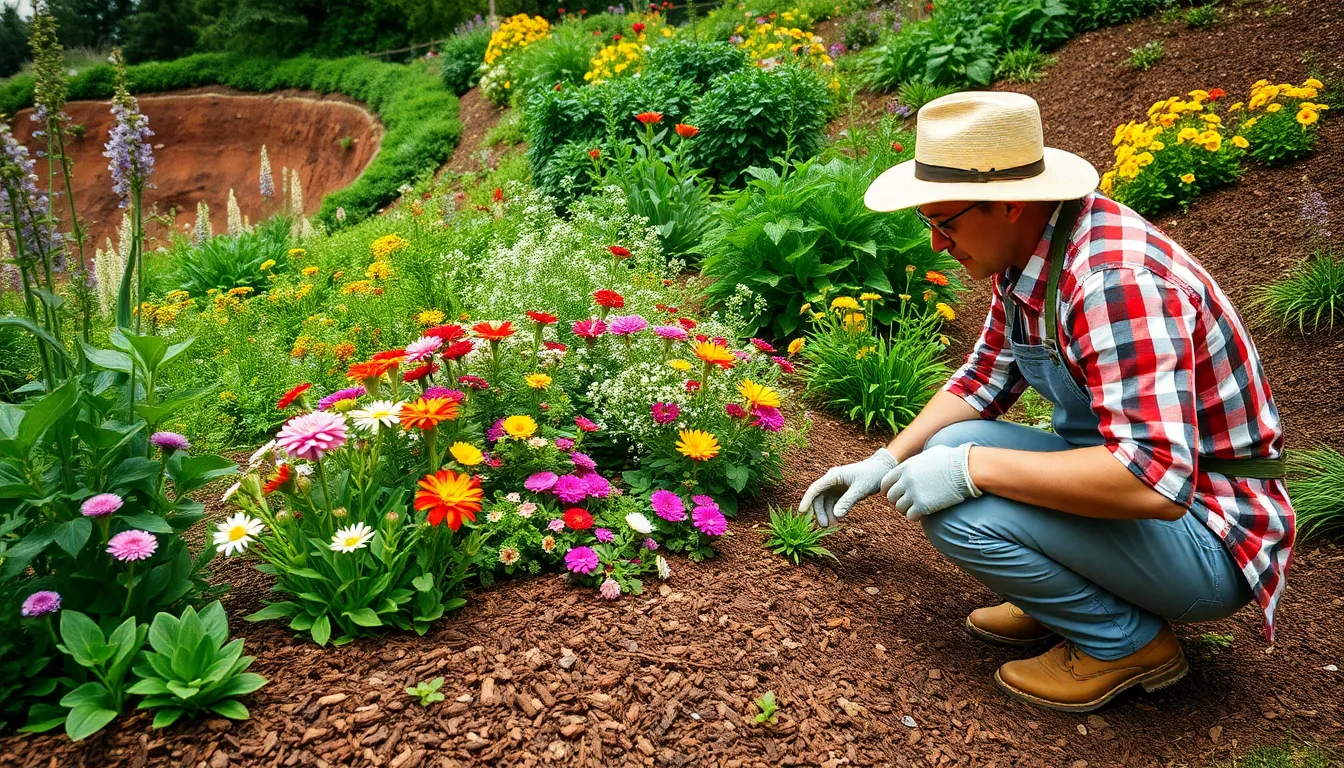
Maintaining hillside gardens requires strategic timing and specialized techniques to ensure long-term success. We’ve developed these essential practices to keep your sloped industry thriving year-round.
Seasonal Care and Pruning Schedules
Timing becomes critical when we manage hillside plants throughout the year. Major pruning should occur in late winter or early spring before new growth begins, allowing plants to recover quickly during the growing season. We recommend conducting thorough inspections for soil erosion and plant health after each rainy season, as water runoff can significantly impact slope stability.
Light pruning and deadheading can happen as needed throughout the growing season to promote continuous blooming and prevent disease spread. Dead or damaged branches require immediate removal to maintain plant vigor and prevent potential hazards on steep terrain. Spring cleaning involves removing winter debris and checking for any signs of plant stress or soil movement.
Fertilization Strategies for Sloped Terrain
Slow-release organic fertilizers applied in early spring reduce runoff risk while providing steady nutrition throughout the growing season. We avoid heavy fertilizer applications on steep areas since gravity accelerates nutrient loss and can contribute to water pollution downstream.
Lighter, more frequent feedings work better for sloped gardens than single heavy applications. Compost or mulch helps retain nutrients and moisture while benefiting root development and improving soil structure on challenging terrain. Granular fertilizers spread more evenly than liquid applications on slopes, staying in place better during rainfall.
| Fertilizer Type | Best Application Time | Frequency | Slope Suitability |
|---|---|---|---|
| Slow-release organic | Early spring | Once annually | Excellent for all slopes |
| Compost | Spring and fall | Twice yearly | Ideal for erosion control |
| Granular balanced | Early spring | 2-3 times per season | Good for established plants |
Long-Term Plant Health Management
Regular inspection schedules help us identify pests, diseases, and nutrient deficiencies before they become serious problems. We replace or rejuvenate underperforming plants as needed to maintain the garden’s overall health and appearance.
Grouping plants with similar water and soil needs streamlines care routines and reduces maintenance time. Strategic plant placement ensures each species receives appropriate growing conditions while contributing to slope stability.
Annual mulch renewal keeps beds looking fresh while providing ongoing erosion protection and moisture retention. We address erosion issues promptly to preserve the garden’s structural integrity and prevent costly repairs later. Keeping beds large and sweeping reduces mowing and edging time while creating more dramatic visual impact on hillside landscapes.
Conclusion
Transforming a hillside into a thriving garden space isn’t just possible—it’s an opportunity to create something truly spectacular. We’ve explored comprehensive strategies that turn challenging slopes into functional and beautiful landscapes that work with nature rather than against it.
The key lies in combining proper planning with sustainable techniques. From terracing and drainage systems to strategic plant selection and maintenance schedules we’ve covered the essential elements that ensure long-term success for your hillside garden project.
Whether you’re drawn to Mediterranean simplicity English cottage charm or modern minimalist design your sloped industry can become the stunning focal point of your outdoor space. With the right approach your hillside garden will provide years of beauty while protecting against erosion and improving your property’s value.
Frequently Asked Questions
What are the main benefits of gardening on sloped landscapes?
Sloped gardens offer excellent natural drainage, preventing waterlogged soil conditions. They create visual depth and dimension, making spaces appear larger and more dynamic. Hillside gardens also provide opportunities for terraced planting, which maximizes growing space while preventing erosion. The varied elevations allow for diverse microclimates, enabling you to grow different plant varieties at different levels.
How wide should terraced garden beds be for easy maintenance?
Terraced garden beds should be 3 to 6 feet wide for optimal accessibility and maintenance. This width allows you to comfortably reach all plants from the edges without stepping on the soil, preventing compaction. Wider beds become difficult to maintain, while narrower beds may not provide sufficient planting space for most garden designs.
What materials work best for building retaining walls on slopes?
Popular retaining wall materials include natural stone for a classic look, concrete blocks for durability, timber for affordability, and gabion walls for modern appeal. Stone offers excellent drainage and weather resistance, while concrete blocks provide structural strength. Timber is budget-friendly but requires maintenance, and gabion walls combine functionality with contemporary aesthetics.
Which plants are best for different terrace levels?
Upper terraces benefit from sun-loving, drought-resistant plants like Mediterranean herbs (lavender, rosemary, thyme). Middle levels work well for vegetables requiring moderate moisture. Lower terraces are ideal for leafy greens and plants that prefer more water. Ground covers like creeping phlox and ajuga help prevent erosion between larger plants.
How can I prevent erosion on steep slopes?
Install deep-rooted ground cover plants to create soil-gripping root networks. Use mulch to protect exposed soil and slow water runoff. Build retaining walls with proper drainage systems including weep holes. Plant shrubs and ornamental grasses as anchor plants, and consider rock placement for permanent erosion control and visual interest.
What drainage systems work best for hillside gardens?
French drains effectively redirect excess water away from planting areas. Install weep holes in retaining walls to prevent water buildup. Consider bioswales and rain gardens to capture and filter stormwater naturally. Drip irrigation systems minimize water waste and reduce runoff compared to traditional sprinkler methods.
How steep can garden pathways be for safe access?
Garden pathways should maintain a maximum grade of 8-10% for comfortable walking. For steeper terrain, use switchback trails that zigzag up the slope, reducing the effective grade. Install steps with handrails for grades exceeding 10%, and create rest areas with viewing points every 50-100 feet on longer climbs.
What’s the difference between Mediterranean, cottage, and modern hillside garden styles?
Mediterranean gardens feature drought-resistant plants like lavender with stone walls and gravel paths. English cottage gardens use tiered plantings with abundant flowers and traditional plants like roses. Modern minimalist designs emphasize clean lines, structural elements, and materials like wood and concrete to enhance the slope’s natural geometry.
When should I perform major maintenance on my hillside garden?
Schedule major pruning in late winter or early spring before new growth begins. Conduct monthly inspections during growing season for erosion signs and plant health. Apply slow-release organic fertilizers in spring to minimize runoff risk. Renew mulch annually, and perform deep watering sessions rather than frequent shallow watering.
Are vertical gardening solutions effective for steep slopes?
Yes, vertical gardening maximizes planting space on steep inclines. Install trellis systems for climbing plants like clematis and roses. Use modular living wall systems with proper drainage for dramatic displays. Combine vertical elements with traditional terracing for comprehensive slope utilization while maintaining soil stability and visual appeal.

